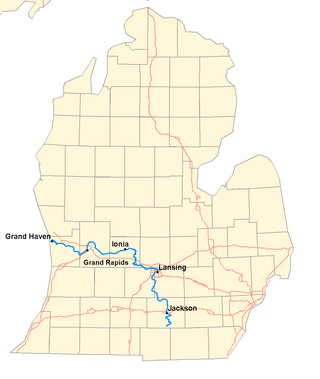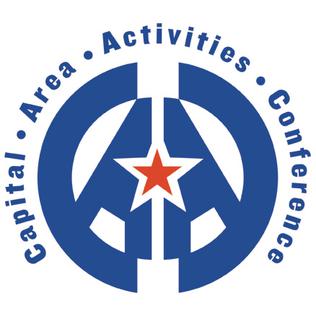
The Grand River is a 252-mile-long (406 km) river in the Lower Peninsula of the U.S. state of Michigan. The longest river in Michigan, the Grand River rises in Hillsdale County, and flows in a generally northwesterly direction to its mouth at Lake Michigan in the city of Grand Haven. The river flows through a number of cities, including Jackson, Lansing, Ionia, and Grand Rapids.
The Pere Marquette Railway was a railroad that operated in the Great Lakes region of the United States and southern parts of Ontario in Canada. It had trackage in the states of Michigan, Ohio, Indiana, and the Canadian province of Ontario. Its primary connections included Buffalo; Toledo; and Chicago. The company was named after Jacques Marquette, a French Jesuit missionary who founded Michigan's first European settlement, Sault Ste Marie.

Michigan Services are three Amtrak passenger rail routes connecting Chicago, Illinois with the Michigan cities of Grand Rapids, Port Huron, and Pontiac, and stations en route. The group falls under the Amtrak Midwest brand and is a component of the Midwest Regional Rail Initiative.

The Great Lakes Central Railroad is an American shortline railroad, operating in the state of Michigan. It was originally called the Tuscola and Saginaw Bay Railway, which was formed on August 26, 1977, to operate over former Penn Central lines from Millington to Munger, and from Vassar to Colling. TSBY's name was derived from the three counties it operated in: Tuscola, Saginaw and Bay.
The Porter Subdivision is a railroad line owned by CSX Transportation in the Chicago, Illinois, area. Formerly a part of the main line of the Michigan Central Railroad, it now connects CSX's former Baltimore and Ohio Railroad line and the Chicago Fort Wayne and Eastern Railroad from the east with the Indiana Harbor Belt Railroad towards Blue Island, Illinois.

The Capital Area Activities Conference is a high school sports league located in Central Michigan. It is a member of the Michigan High School Athletic Association (MHSAA). There are currently 21 member schools in the conference that come from the counties of Clinton, Eaton, Ingham, Ionia, and Livingston. The Capital Area Activities Conference Logo was designed by Lansing Catholic 2003 graduate Raymond B. Corey.

The Pere Marquette is a passenger train operated by Amtrak as part of its Michigan Services on the 176-mile (283 km) route between Grand Rapids, Michigan, and Chicago, Illinois. It is funded in part by the Michigan Department of Transportation and is train 370 eastbound and train 371 westbound. The westbound train leaves Grand Rapids during the morning rush, and the eastbound train leaves Chicago after the afternoon rush, enabling same-day business travel between the two cities.

New Buffalo station is a train station in New Buffalo, Michigan, served by Amtrak, the United States' passenger railroad system. The Blue Water stops once daily, and Wolverine (Chicago–Detroit/Pontiac) stops three times daily in each direction.

Railroads have been vital in the history of the population and trade of rough and finished goods in the state of Michigan. While some coastal settlements had previously existed, the population, commercial, and industrial growth of the state further bloomed with the establishment of the railroad.

The Mid-Michigan Railroad is a railroad owned by Genesee & Wyoming. It operates 39.8 miles of track in Michigan.
The Detroit, Lansing and Northern Railroad (DL&N) is a defunct railroad which was formed on December 27, 1876 as a reorganization of the foreclosed Detroit, Lansing and Lake Michigan Rail Road. The segment of its main line from Detroit to Lansing became an important component of the Pere Marquette Railroad, organized in 1900, and is still in use by CSX.
The Chicago and West Michigan Railway (C&WM) is a defunct railroad which operated in the state of Michigan between 1881 and 1899. It was one of the three companies which merged to become the Pere Marquette Railway.
The Ionia and Lansing Rail Road is a defunct railroad which operated in the state of Michigan in the 1860s and 1870s. The company incorporated on November 13, 1865; the investors hailed primarily from Lansing, Ionia and Portland. The original charter called for a 34-mile (55 km) line from Ionia to Lansing; on January 13, 1869 this was amended with a much grander vision: a 125-mile (201 km) line from Lansing to the mouth of the Pentwater River at Pentwater, on the shores of Lake Michigan.
The Detroit and Howell Railroad (D&H) is a defunct railroad organized in 1864 to build a line connecting Howell and Detroit in southeast Michigan.
The Toledo Division was the southern half of the Pere Marquette Railway's main line, which ran from Ludington, Michigan to Toledo, Ohio. The Toledo Division encompassed the portion which ran from Toledo north to Saginaw, Michigan, where it met the Ludington Division. The line was built by a predecessor of the PM, the Flint & Pere Marquette, and is currently owned by CSX Transportation.
The Grand Rapids, Lansing and Detroit Railroad is a defunct, nineteenth century railroad, formerly operating in Michigan. Incorporated May 17, 1887, it built a 53-mile line from Grand Rapids, Michigan to Grand Ledge, as well as the Ramona Branch, both of which it leased to the Detroit, Lansing and Northern Railroad. The former still exists as part of the CSX line into Grand Rapids, Michigan.
The Saginaw Subdivision is a railroad line in the U.S. state of Michigan. The line runs 105 miles from Toledo, Ohio, to Saginaw, Michigan. CSX owns the line although since 2006, the section from Mt. Morris to Saginaw has been leased to the Lake State Railway but is still occasionally used by CSX. The Plymouth to Mt. Morris line was also leased to LSRC starting in March 2019.
The Detroit, Lansing and Lake Michigan Railroad (DL&LM) is a defunct railroad which built and operated the first rail line between Detroit and the state capital Lansing. Though the corporation was short-lived, much of the route it placed in service is still in use by CSX.

The Grand Rapids Subdivision is a railroad line in Western Michigan and Northern Indiana. It runs 136 miles (219 km) from Porter, Indiana to Grand Rapids, Michigan. It was built between 1870–1903 by the Chicago and Michigan Lake Shore Railroad and its successor the Pere Marquette Railroad. CSX Transportation owns the line today. In addition to freight traffic, the line hosts Amtrak's daily Pere Marquette.











